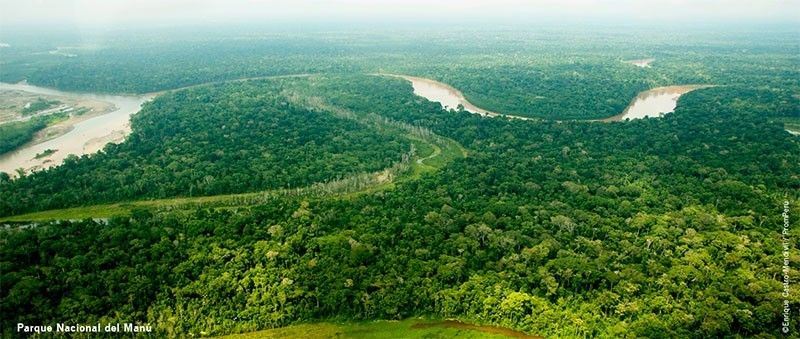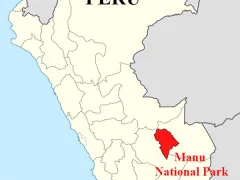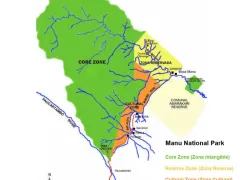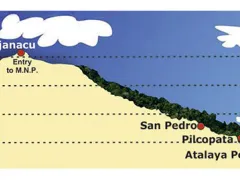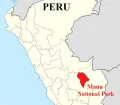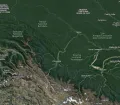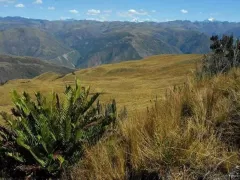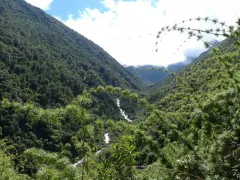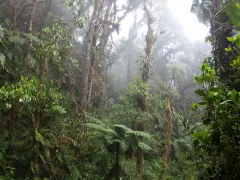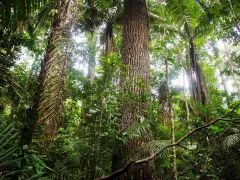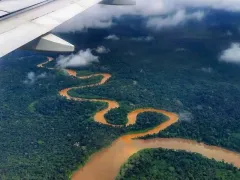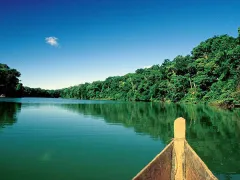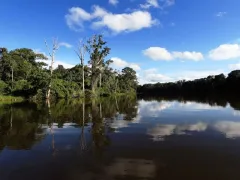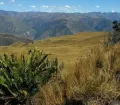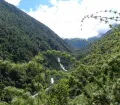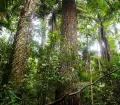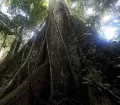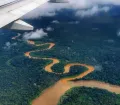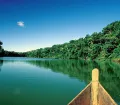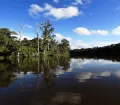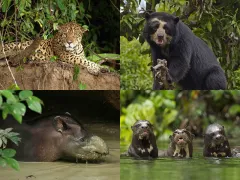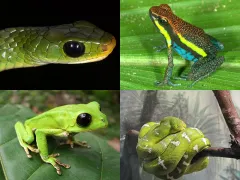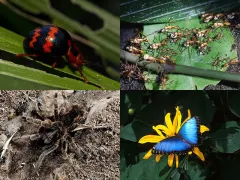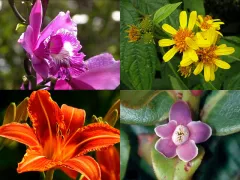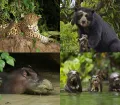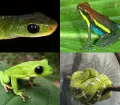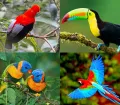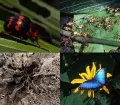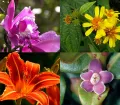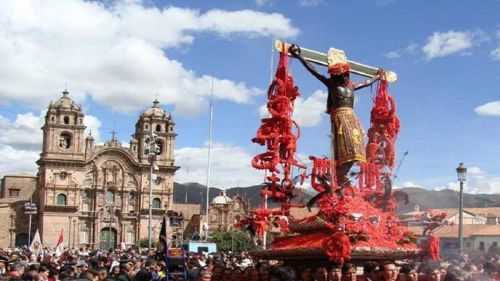The Manu National Park in Peru is one of the most breathtaking and beautiful natural areas in the world. Because of its sheer size, its different vegetation zones and its protective remoteness, a unique, almost untouched ecosystem could survive until today. Manu not only provides a living space for an immeasurable diversity of plant and animal species, but also for native indigenous tribes and peoples of the Peruvian Amazon region.
Even today, traveling to the Manu National Park is a fascinating adventure and highlight of any Peru trip you will remember all your life.
General Information about Manu National Park
Manu National Park, the largest national park in Peru, was established in 1973, recognized by the UNESCO as Biosphere Reserve in 1977 and declared a World Heritage Site in 1987. The park covers an area of nearly 1.8 million hectares.
It is located in the southeast of Peru northeast of Cusco and extends from the eastern mountain range of the Andes down into the Amazon lowlands. Thanks to the altitude difference of around 3800 m (12,500 ft) the Manu National Park accommodates different ecological zones such as the High Andean Plain or Puna Grassland, the Andean Dwarf Forest, the Cloud Forest and the Tropical Rainforest.
To protect the existing unique biodiversity of the Manu National Park and to preserve the nomadic lifestyle of the indigenous tribes living there for generations, the park was divided into three zones:
- The Core Zone (Zona Nucleo or Zona Intangible) accounts for about 80% of the park and is strictly reserved for the indigenous tribes enabling them to pursue their traditional ways of living without modern influences. Additionally, the biological research station Cocha Cashu is located in this part of the Manu Park which is dedicated solely to the preservation of the unique flora and fauna. In special cases a permit is granted to scientific researchers for anthropological and biological research limited to the observation of the life and ecological processes. Otherwise the Core Zone is closed to visitors.
- The Reserve Zone (Zona Reservada, Zona Experimental or as well Zona de Amortiguamiento) occupies about 15% of the Manu National Park. It extends along the Manu River from Boca Manu to the Panagua River and captivates with amazing virgin landscapes and an immense diversity in wildlife and vegetation. The Reserved Zone is under special protection: only controlled scientific research and ecotourism is permitted. Visitors can enter this area of the Manu National Park only with a licensed tour operator, that has to meet the strict rules and guidelines. The nights are spent in one of the lodges or in tent camps.
- The Cultural Zone (Zona de Transición or Zona Cultural) makes up around 5% of the Manu National Park and extends along the Alto Madre de Dios River southeast of the Core Zone. The Cultural Zone doesn’t enjoy legal protection and is freely accessible. In this area mainly some native tribes settled in small villages being able to make a living from agriculture, husbandry and forestry as well as having a basic health and education infrastructure. Many comfortable and convenient lodges, built using local materials, are as well located in the Cultural Zone accommodating visitors.
Wildlife & Animals in the Manu National Park
In 2014 a study revealed that the Manu National Park accommodates the greatest diversity of terrestrial vertebrates worldwide. Over 220 different mammal species live in Manu. Jaguars, pumas, ocelots and spectacled bears can be found as well 13 different monkey species such as spider monkeys, titi monkeys and tamarins. Among many, many others, the Manu National Park also offers tapirs, anteaters, armadillos and sloths a home.
Additionally, Manu National Park is the area with the largest biodiversity of amphibians and reptiles in the world. Until today 155 amphibian species (frogs, toads and salamanders) and 132 reptile species (snakes, lizards, turtles, iguanas, geckos and caimans) could be identified in Manu and regularly new species are discovered.
The Manu National Park is also a birdwatcher's paradise: more than 1,000 different bird species, about 10% of all bird species worldwide, can be observed, including a variety of parrots and macaws, toucans, hoatzins, parakeets and hummingbirds.
Furthermore, over 1300 butterfly species, about 650 beetle species, more than 300 ant species, over 130 dragonfly species and around 200 fish species could be specified so far. However, other previously unknown species are discovered regularly.
Plants and Trees in the Manu National Park
Because of the topographic circumstances the Manu National Park has more microclimates than any other region in the world, so that an incomparable diversity of plant species prospers throughout the reserve. Over 20,000 plant species are already identified. But here again scientists are convinced that they haven’t yet discovered all what there is to be discovered. It is believed that quite a few completely unknown species are still out there that have the one or other surprise, especially for medical applications, in store.
Impressive for most visitors are surely the massive giant trees in the tropical rainforest with heights of over 60m (more than 200 feet) and a diameter of 8m (about 26 feet). Here as well countless beautiful species of palm trees and lianas grow. The cloud forest captivates the visitors with a wide variety of orchid species, ferns and fungi, while grass-lands are omnipresent in the Andean highlands.
Travel advice for a trip to the Manu National Park
For a trip to the Manu National Park you should plan 6 to 7 days. The journey there and of course the park itself is a unique, really unsurpassable experience and adventure.
How to get to Manu?
Countless travel agencies in Peru and worldwide offer tours to the Manu National Park. And even if you are on a budget, you can make the trip from Cusco to Manu’s Cultural Zone by bus on your own. However, when you plan to visit the Reserve Zone, you must book your Manu trip with one of the few licensed Manu tour operators; these include Amazon Trails Peru, Expediciones Vilca, IncaNatura, Manu Expeditions, Manu Nature Tours, Pantiacolla Tours and SAS Travel to just name a few.
Cusco to Manu
Your trip to the Manu National Park usually starts in Cusco in the early morning. From there the journey takes you on road by public or private bus, minivan or SUV to Paucartambo and further on to Atalaya (8-12h). Depending on your plans the tour continues by boat on the Alto Madre de Dios River to Boca Manu (6h-12h)) and probably even deeper into the rainforest on the Manu River. Even though the overland drive and boat trip is exhausting and tiring, there surely isn’t anything more beautiful and fascinating than travelling from the Andean highlands down to the green Amazon basin and into the jungle.
Some tour operators also offer flights from Cusco to Boca Manu and vice versa (30 minutes). So, those preferring to avoid a long bus trip or with little time, have the option to travel to Manu in less than an hour. In some cases, it might be recommendable to travel on road to Manu and fly back out.
Puerto Maldonado to Manu
You can also get to Manu from Puerto Maldonado; first on road along the inter-oceanic highway to the village of Santa Rosa (2h) or to Puerto Carlos where you cross the Inambari River by boat and continue on road (1h) to Boca Colorado. From there your journey continues on the Madre de Dios River in a motorboat until reaching the control post on the Manu River (7-8h).
Best time to travel to Manu
The Manu National Park is open year-round. However, the best time to travel to Manu is from April to November. In February and March, during the rainy season, roads and dirt tracks might be flooded and landslides are common. So the trip on road from Cusco to Manu can get extremely difficult.
Health
Yellow fever, malaria and leishmaniasis are present in the Peruvian Amazon region. Although the Manu National Park seems to be free of these diseases and not one case was reported in the last years, there is always a risk of infection. So please take the for you necessary precautions. Some tour operators ask for a yellow fever vaccination when booking a Manu trip.
For more health and medical related information read our article "Health and medical care in Peru".
Enjoy your trip!


